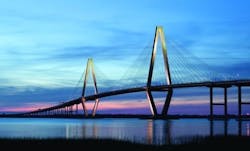Deck on Cooper River Bridge in for the long haul
The two original bridges crossing the Cooper River were functionally obsolete. The Grace Memorial Bridge carried traffic for 76 years and had two narrow 10-ft lanes, did not have any shoulders and was limited to carrying vehicles weighing less than 5 tons. Because of the weight limit on the Grace Bridge, all Charleston-bound heavy trucks, recreational vehicles and busses were diverted to the single southbound lane on the Pearman Bridge. The Pearman Bridge, built in 1968, had three 12-ft lanes but did not have shoulders or a median separating its northbound and southbound traffic.
The answer? Construct a new bridge capable of replacing both existing bridges.
The signature design for the Cooper River Bridge, the longest single cable-stay bridge in North America, evolved from public input, engineering requirements, and the expertise of the world’s leading bridge and lighting designers. Its construction increased the capacity of U.S. 17 over the Cooper River to accommodate area growth predictions and improved traffic safety by meeting current design standards and eliminating substandard safety factors. The new bridge also reduced the frequency and costs of the major bridge-maintenance activities that were necessary because of the age and design of the existing bridges.
Because of the performance requirements demanded of the Cooper River Bridge, it needed a road that could flex as needed, hold up to heavy traffic loads and deliver many years of trouble-free service. The project team—Latex Systems Inc., the latex distributor, and Cleco Corp., the bridge-deck overlay contractor—selected Styrofan 1186, a latex-modified concrete from BASF that provides flexural strength and durability.
“The latex-modified concrete bridge deck overlay used on all of the cable-supported deck sections of the bridge provides significant benefits,” said J.W. Harman, president, Cleco Corp. of Rosedale, Va. “Since the deck panels were precast and then lifted into place, some dimensional variances in the road surface needed to be addressed. The beauty of the latex-modified concrete overlay is that it compensates for those dimensional variances. More importantly, it adds a great deal of extra strength and flexibility to the road surface that keeps it in good condition for a long time, and helps the bridge deck last much longer.”
The deck overlay system offered substantial advantages to the project, including higher flexural strength with tremendous adhesion, reduced formation of voids and cracks during the curing stage, improved compressive strength, increased abrasion resistance, resistance to penetration of oil, water and salt, reduced freeze-thaw damage and an extended lifespan of the bridge up to 30 years. The typical life expectancy for a bridge in this region is 40 years, but the addition of the 2-in. latex-modified concrete overlay brings the life expectancy for the Cooper River Bridge up to 70 years. And when the overlay’s service life reaches its end, it can be removed and a new 2-in. overlay applied to renew the deck for another 30 years of maintenance-free service.
